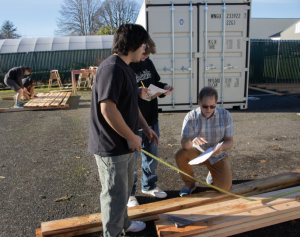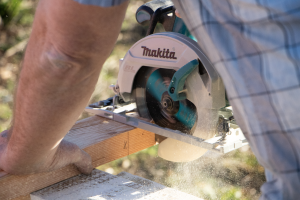On a rare sunny Tuesday in December, students in Don Willson’s construction and geometry class at Battle Ground High School file outside to an open spot near the greenhouses along Main Street. They pull tarps off of lumber piles and open cargo containers, pulling out a selection of cordless tools.
Under the watchful eyes of Willson and math teacher Matt Gamblin, students spread out to different stations. Some oversee the operation, while others practice measuring the pieces they need to build the various parts of what will eventually become a greenhouse.
Romario Fajardo-Zuniga calls himself a “math fanatic” who enjoys the challenge of figuring out measurements and seeing a project come together.
“I also think the class teaches a lot of teamwork,” the junior said. “Sometimes we can get used to doing things by ourselves, and it’s helpful to know you have a team.”
Sophomore Wolfgang Schefers agrees. Since he’s not into sports, he finds that Willson’s class provides much of the same sort of skill building when it comes to working as a team.
“You get into this flow of working with others, building connections with them while you figure out how to build a house,” Schefers said. “It just feels good. It’s a really nice class to be in.”
Weathering the elements
Willson’s construction class is part of a broad array of career and technical education offerings in Battle Ground Public Schools, fulfilling a strong local interest in the skilled trades. But there are limitations given the school’s current setup. With no covered area to work in, students often can’t work on projects for days or even weeks at a time.
“Having a building would allow us to not have to set up every day,” Willson said, noting that the process often eats up nearly half of their class time. “It would also put us on the map in terms of not only having this program, but being able to invite other schools here to compete for carpentry.” He envisions a space that would allow them to even build tiny homes or other large-scale projects, or host competitions put on by SkillsUSA.
Meeting a growing need
The U.S. Bureau of Labor Statistics estimates there were more than 450,000 construction industry jobs left vacant at the end of 2022. That number is expected to rise sharply in the coming years as a wave of retirements hits the skilled trades. In Southwest Washington, data shows that there are more annual job openings in the construction and extraction industries than in any other sector.
The demand for workers has led to an increased focus on partnerships at the secondary level. Today, many high school students can earn credits while working part time as part of the district’s work-based learning program. But without a proper space to work in, Willson says, it’s difficult to build partnerships within the local construction industry.
 Funding for a covered area will be included in a three-year capital levy approved by voters during the Feb. 13, 2024 special election. Capital levy funding will also provide updates for culinary arts and health sciences programs, both also high-demand industry sectors.
Funding for a covered area will be included in a three-year capital levy approved by voters during the Feb. 13, 2024 special election. Capital levy funding will also provide updates for culinary arts and health sciences programs, both also high-demand industry sectors.
For Willson, though, the class isn’t only about getting kids into the construction industry.
“The kinds of skills they’re learning in this class–learning to use tools safely, learning to work cooperatively with other people, thinking through a problem and figuring out how to solve it–those are all things they can use in other areas of their lives,” Wilson said. “Those kinds of skills are applicable no matter what.”

